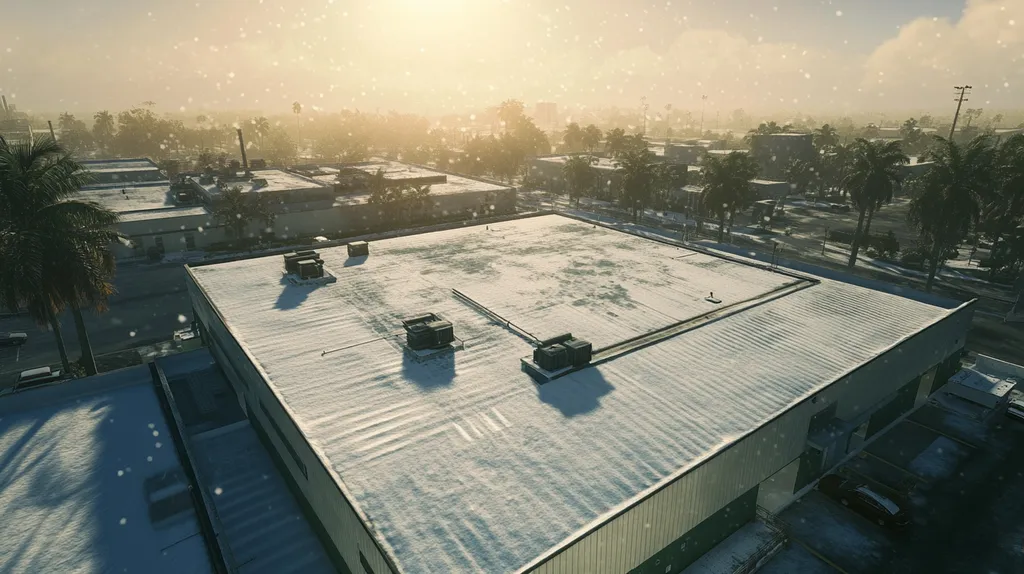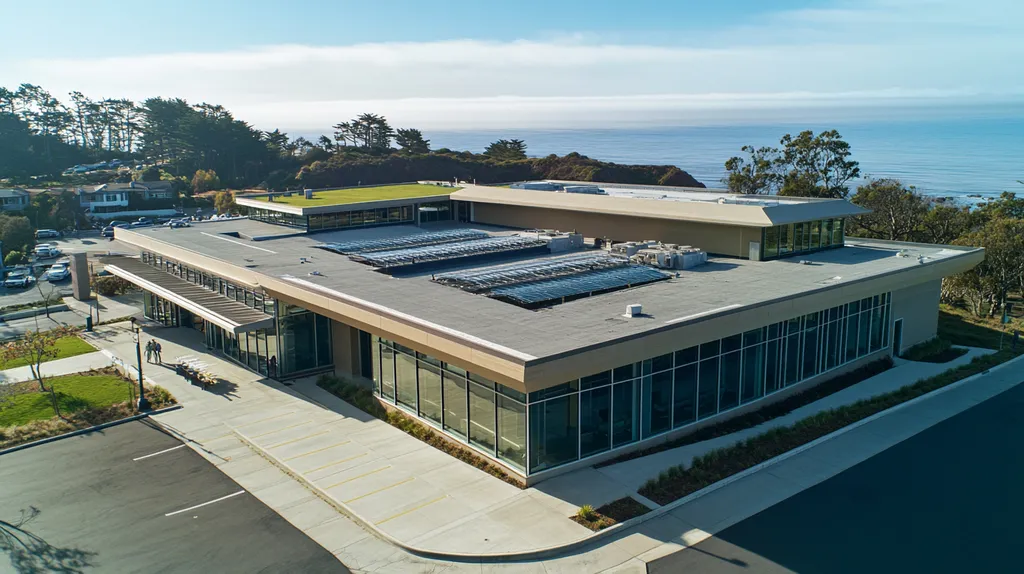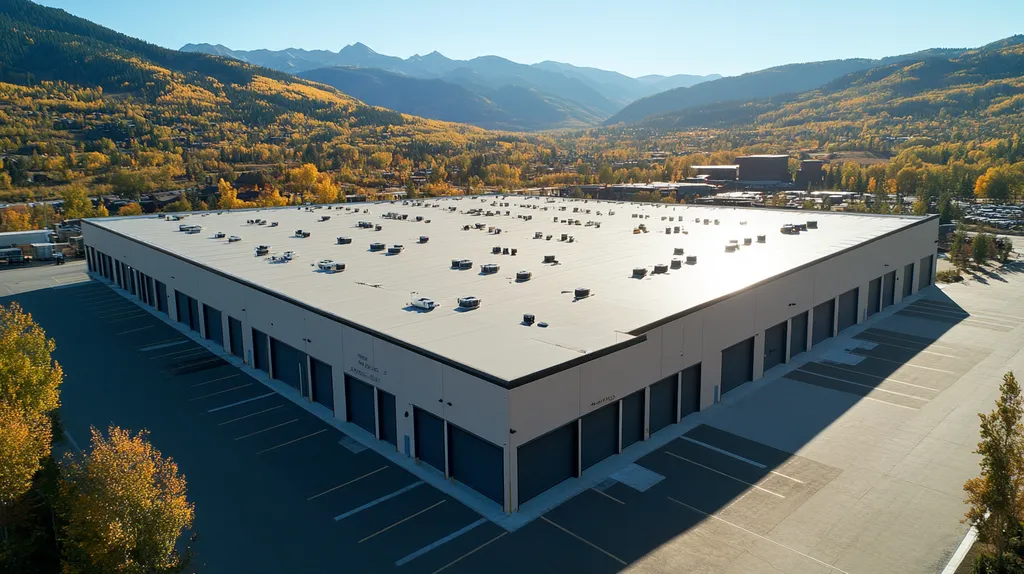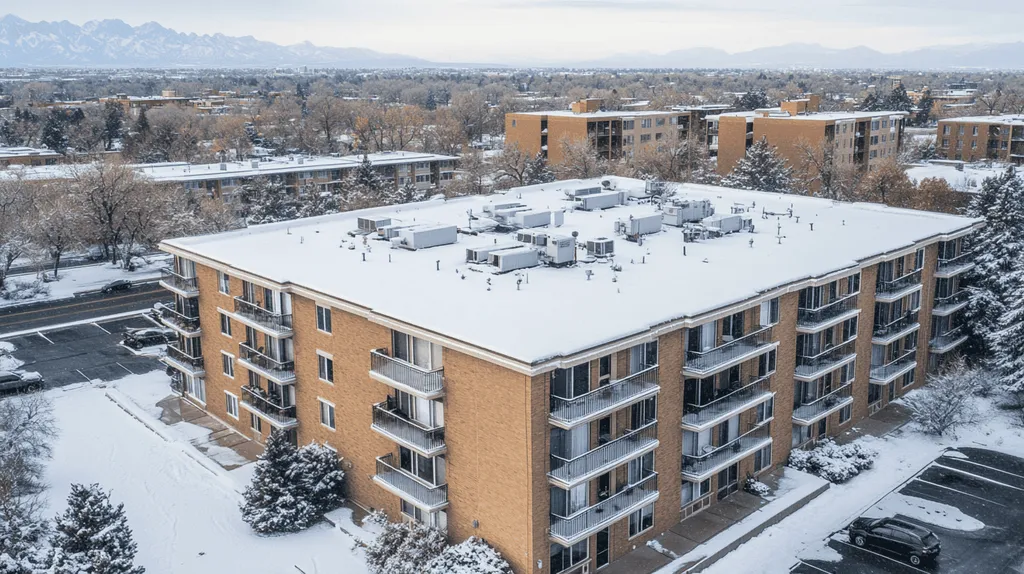As commercial buildings evolve, inadequate planning for rooftop equipment needs leads to over $3.2 billion in avoidable structural damage annually across North America. Nearly 40% of commercial roof failures stem from improper equipment installation or insufficient load planning.
For property owners and facility managers, understanding how to effectively plan for future rooftop equipment is no longer optional – it’s essential for protecting both infrastructure investments and operational continuity.
This comprehensive guide examines the critical aspects of equipment planning, from fundamental concepts through optimization strategies, providing actionable insights for sustainable roofing solutions.
SECTION 1: FUNDAMENTAL CONCEPTS
Effective planning for future equipment needs on commercial roofs is essential for maintaining safety and operational efficiency. Poorly executed plans can lead to expensive modifications or serious structural failures. Alarmingly, statistics reveal that approximately 30% of commercial roofing problems arise from unexpected rooftop load, emphasizing the need for thoughtful, strategic planning.
Understanding Commercial Roofing Needs
Commercial roofs have diverse roles, offering protection and promoting energy efficiency. Each type of building faces distinct challenges, which calls for customized roofing solutions. It’s crucial for property owners and facility managers to assess specific requirements based on usage, environmental conditions, and building architecture.
For instance, a warehouse roof may need to support heavy machinery, while a retail space might prioritize aesthetic appeal and energy-efficient features. Recognizing these needs is important for making informed roofing choices, as it helps determine which system features are truly necessary.
Furthermore, building codes and regulations significantly impact roofing decisions. Adhering to local codes not only bolsters safety but also influences material and design choices. Being aware of these regulations upfront can save property owners from potential headaches later on.
Ultimately, a solid understanding of a building’s overall needs sets the foundation for effective planning and sustainable, long-term roofing solutions.
Types of Commercial Roofs and Materials
Various types of commercial roofs exist, each presenting specific benefits and drawbacks. Common flat roofing materials like TPO, EPDM, and modified bitumen each react differently to environmental factors and rooftop weight.
TPO roofs are not only energy-efficient but also puncture-resistant, making them ideal for buildings housing significant equipment. EPDM’s renowned durability allows it to thrive in diverse climate conditions. Meanwhile, modified bitumen is flexible and easy to install, catering to varied building designs and needs.
When selecting roofing materials, it’s essential to consider anticipated future equipment loads. Some materials may sag under excessive weight, potentially leading to costly structural issues later on. Understanding how different materials perform in tandem with building environments aids in making better-informed decisions.
Moreover, weighing the longevity of these materials against future modifications is vital. Investing in a high-quality roofing system can yield long-term returns by reducing maintenance costs and extending the roof’s service life.
Importance of Safety Assessments
Safety assessments are indispensable during the planning phases for future rooftop equipment installations. A comprehensive evaluation can pinpoint potential hazards, such as load limits and necessary ventilation. Without these assessments, adding rooftop equipment may jeopardize the building’s integrity.
For example, introducing HVAC units without following safety guidelines could push the roof beyond its load capacity. This oversight might lead to dire consequences, including structural damage or accidents involving staff. Conducting routine safety evaluations fosters proactive adjustments and underlines the necessity of compliance.
Regular inspections can also reveal wear and tear on roofing materials. Detecting these issues early can prevent copious repairs and extend the roof’s lifespan. Ignoring known problems often leads to larger, more costly complications in the future.
In the end, safety assessments not only protect the building and its occupants but also safeguard investments in both equipment and roofing systems.
SECTION 2: SYSTEM COMPONENTS
Understanding the system components of commercial roofing is essential for long-term planning and functionality. With rising operational costs and the need for reliability, property owners must be equipped with knowledge about the materials and tools necessary for effective roofing. Alarmingly, about 80% of roof failures stem from improper installation or maintenance, making informed component selection critical for avoiding costly mistakes and ensuring roof durability for years to come.
Common Materials and Tools Used
Selecting appropriate materials is paramount for achieving longevity and energy efficiency in commercial roofing. Common options like thermoplastic polyolefin (TPO), ethylene propylene diene monomer (EPDM), and built-up roofing (BUR) each offer tailored advantages suited for different environments. For instance, TPO is particularly valued for its energy efficiency, making it a great choice for urban settings with high energy demands.
Complementing these materials, tools like roofing knives, seam rollers, and hot-air welders play a vital role in ensuring proper installation and maintenance. Utilizing the correct tools minimizes the risks of leaks and damage while enhancing the efficiency of installers. Additionally, cutting-edge technology such as infrared thermography can proactively identify potential issues in roofing systems, preventing more significant concerns later on.
Moreover, property owners should factor in regular maintenance tools when planning. Essentials like roof hatches and access ladders need to be easily accessible for inspections. Properly equipped facilities not only support ongoing maintenance efforts but also reinforce the roofing system’s performance over time.
By making well-informed material selections and investing in the right tools, owners can establish a robust roofing system capable of meeting both current and future demands.
Equipment for Different Roof Types
Tailoring equipment for various roof types is crucial when planning for future needs. Typically, flat roofs accommodate HVAC systems, solar panels, and drainage systems, necessitating supports that evenly distribute weight. In contrast, sloped roofs usually focus on drainage and demonstrate greater stability with less equipment weight.
For instance, a membrane roof can efficiently support rooftop units to regulate building temperatures effectively. Conversely, sloped roofs often require distinct equipment configurations because of variation in load capacities and surface drainage patterns. Recognizing these differences in roof characteristics is a cornerstone of effective long-term planning.
Furthermore, the chosen equipment must be compatible with ongoing maintenance and potential upgrades. A thoughtfully planned rooftop layout not only welcomes future installations but also avoids clashes with existing structures. This strategic foresight can limit costs and avert structural complications, thus maximizing the roof’s lifespan.
As innovations in roofing equipment and materials progress, property owners should remain attentive to new technologies. The emergence of energy-efficient systems can offer unforeseen advantages, enhancing sustainability and functionality over the roof’s service life.
Essential Safety Equipment
Safety considerations are paramount in commercial roofing, particularly when preparing for equipment installation and maintenance. Given that a significant number of accidents occur during roofing work, protective measures must be prioritized. Personal protective equipment (PPE) such as harnesses, helmets, and high-visibility clothing should be standard for every roofing crew member.
Investment in effective safety measures like safety nets and guardrails is crucial, especially for flat roofs, to help prevent falls and related accidents. Establishing a safe working environment enhances labor efficiency and mitigates liability risks for property owners and operators.
Equally important is the ongoing training of the roofing workforce. Regular safety drills and updated training on equipment usage significantly reduce the likelihood of workplace injuries. It is essential for property owners to incorporate these training efforts into their long-term planning for equipment needs.
By integrating safety into the planning process, risks associated with roofing projects can be significantly reduced. A proactive investment in safety not only protects personnel but also leads to substantial long-term savings by minimizing accidents and ensuring a dependable workforce.
SECTION 3: IMPLEMENTATION METHODS
With the increasing demand for commercial roofs that can support advanced equipment, property owners must prioritize effective implementation methods. Neglecting to establish a well-crafted plan can result in costly renovations or structural dilemmas down the line. Remarkably, about 60% of roof failures are attributed to inadequate planning and installation practices. This section highlights the essential methods to ensure roofs are primed for future equipment needs.
Developing a Comprehensive Plan
The foundation of a successful roofing project rests on a comprehensive plan. Property owners should start by assessing both current and future equipment needs. Collaborating with roofing professionals allows for a thorough analysis of weight loads, space requirements, and maintenance access.
This planning phase also includes a critical review of local building codes and regulations. Adhering to these guidelines ensures that future installations avoid legal challenges and safety issues. Partnering with experienced contractors expedites this process, offering valuable insights into best practices and design considerations.
It’s equally important to factor in potential equipment upgrades within the long-term strategy. A flexible roofing infrastructure can adapt to evolving technology, reducing disruptions and minimizing financial strain.
By emphasizing thorough planning, property owners can mitigate risks and prepare their buildings for future demands, ensuring sustainable operations.
Preparing the Installation Site
Once the plan is established, the next step is the proper preparation of the installation site. This process is crucial to ensuring the roof can support the intended equipment. Conducting a thorough structural analysis reveals any weaknesses in the existing roofing system.
It may be necessary to incorporate proper insulation and structural reinforcements to accommodate additional weight. Ignoring these elements can lead to leaks or even catastrophic structural failure, wasting valuable time and resources.
Additionally, property owners should assess any existing equipment or rooftop gardens to understand their impact on the new installations. Clearing the area of obstacles is vital for facilitating a smooth installation process while protecting existing infrastructure.
Ultimately, careful planning and execution at this stage significantly influence the roof’s longevity and performance, making it an essential component of the implementation methods.
Installing and Securing the Roof
The effective installation and securing of the roof are crucial for safeguarding investments and ensuring long-term functionality. Selecting high-quality materials suitable for the specific environment is vital to preventing common roofing issues. For instance, materials like thermoplastic polyolefin (TPO) or ethylene propylene diene monomer (EPDM) offer excellent durability against various weather conditions.
Following proper installation techniques is essential for achieving seamless integration with existing structures. Special attention should be paid to sealing joints and seams, as these are common failure points that can lead to unwanted leaks.
Moreover, arms and mounts for new equipment must be securely anchored to withstand shifting or damage during severe weather. Conducting regular inspections both during and after installation provides opportunities to spot potential issues early.
In summary, methodical and proficient installation not only addresses immediate operational needs but also extends the overall lifespan of the roofing system, forming a solid foundation for future requirements.
SECTION 4: MAINTENANCE REQUIREMENTS
As commercial roofs increasingly support various equipment, diligent maintenance becomes vital for ensuring their longevity and functionality. Failing to conduct regular upkeep can lead to severe damage, expensive repairs, and disruptions that impact business operations. Alarmingly, studies indicate that insufficient maintenance can reduce the lifespan of roofing systems by as much as 30%. This section emphasizes the importance of regular equipment inspections, establishing solid maintenance schedules, and swiftly addressing defects and damages.
Regular Equipment Inspections
Routine inspections of roof-mounted equipment are essential for detecting potential issues before they escalate. Conducting evaluations at least twice a year ensures that equipment such as HVAC systems and antennas remains functional and does not jeopardize the roof’s integrity. Qualified professionals should check for signs of wear, corrosion, or leaks, which could compromise roofing materials.
Documenting inspection results provides valuable insights into the status of both the equipment and the roof. This record also assists in adhering to safety standards and maintaining manufacturer warranties. Additionally, regular inspections facilitate the early detection of water pooling or debris accumulation, both of which can hasten roof deterioration.
Partnering with a reputable roofing contractor for these inspections can strengthen the assessment process. They bring specialized knowledge about how different equipment interacts with various roof materials, helping to prevent costly oversights.
By prioritizing inspections, property owners can significantly reduce long-term risks and enhance the operational efficiency of the roof and its equipment.
Maintenance Schedules and Checks
Creating a comprehensive maintenance schedule is critical for ensuring both equipment longevity and optimal roof performance. A well-defined schedule should incorporate regular cleanings, lubrication of parts, and filter replacements, tailored to each equipment type. For instance, HVAC units typically benefit from seasonal checks that optimize their performance and energy efficiency.
Developing a maintenance calendar allows facility managers to coordinate repair efforts and avoid missing critical tasks. Scheduled maintenance can minimize emergencies and reduce associated costs, ultimately preserving the roofing system’s integrity and extending its lifespan.
Effective communication with manufacturers can provide insights into recommended maintenance practices and timelines. Facility managers should keep detailed records of all services performed, creating a historical guide for future maintenance decisions. This documentation is crucial for analyzing trends and anticipating future needs.
Moreover, utilizing maintenance management software can streamline scheduling and ensure compliance. This proactive approach supports decision-making about future equipment needs and helps in managing budget allocations efficiently.
Addressing Defects and Damages
Timely attention to defects and damages is essential to prevent minor issues from escalating into major problems. When equipment exhibits signs of malfunction, such as leaks or unusual noises, it is crucial to investigate and resolve these issues immediately. Ignoring these symptoms could lead to roof damage and adversely affect the lifespan of both the roof and the equipment.
Implementing a reporting system for defects can empower building occupants to notify management promptly. A proactive response enhances safety and fosters a culture of responsibility regarding roof upkeep. Scheduled maintenance checks should also prioritize reviewing previous repairs to ensure that prior interventions remain effective.
In some cases, property owners may need to hire specialized contractors for repairs, like certified roofers or HVAC technicians. This targeted approach guarantees that repairs meet industry standards and do not create further damage.
Swiftly addressing issues not only protects the roof and its supporting structures but also supports the overall functionality of the equipment. Being proactive in repairs can save property owners time and costs in the long run.
SECTION 5: PERFORMANCE METRICS
Monitoring performance metrics is not just a best practice but a necessity for maintaining the integrity of commercial roofs. These roofs support various equipment while enduring a range of environmental challenges. Data-driven insights can prevent costly failures and enhance safety compliance. According to studies, roofs that lack regular evaluations can incur maintenance costs up to 30% higher annually. This section will explore three essential metrics: weather conditions, equipment utilization, and safety compliance, to empower property owners in their future roofing decisions.
Monitoring Weather Conditions
Understanding weather conditions is crucial for preserving the structure and functionality of commercial roofs. Extreme temperatures, heavy rainfall, and significant snow accumulation pose threats both to the roof itself and the equipment it houses. By closely monitoring these variables, facility managers can proactively identify potential damage and schedule necessary inspections.
For example, a facility located in a snow-prone area should have a robust strategy for addressing heavy snow loads. Installing weather sensors can automate monitoring, providing real-time data to aid in informed decision-making. Failing to heed weather warnings can result in catastrophic structural failures, jeopardizing both safety and operations.
Furthermore, a weather monitoring system aids in determining maintenance needs. By linking weather events to roofing issues, managers can implement preventative measures to prolong the roof’s lifespan. Therefore, a proactive approach is critical to optimize roof performance.
Incorporating weather monitoring as part of routine maintenance can save property owners from hefty emergency repairs and ensure ongoing operational efficiency.
Tracking Equipment Utilization
Tracking equipment utilization is essential for assessing the performance of commercial roofs. Knowing the weight and spatial demands of rooftop equipment helps ensure structural integrity and operational efficiency. Property managers often underestimate how much weight accumulates from installed equipment over time.
A systematic approach includes regularly reviewing the roof’s load-bearing capacity against actual usage data. For instance, adding a new HVAC unit necessitates an immediate assessment of its impact on the roof. Neglecting this can lead to overloading, which may result in leaks or structural damage.
Implementing an inventory management system for equipment can facilitate accurate tracking and support future expansion decisions. This data-driven strategy can help prioritize maintenance needs, ultimately enhancing the roof’s overall lifespan.
In summary, establishing effective tracking systems for equipment utilization streamlines operations and mitigates safety hazards posed by overloaded roofs.
Assessing Safety Compliance
Safety compliance is paramount when managing commercial roofs, given the potential hazards linked to maintenance work and equipment operation. Regular assessments are crucial for ensuring that safety regulations and standards are met, thereby reducing liability risks.
Facilities must adhere to OSHA guidelines relevant to roofing work. Routine safety audits help identify any compliance issues, such as insufficient fall protection systems that could expose workers to dangers. By thoroughly evaluating safety practices, companies can foster a culture of safety that protects their workforce and minimizes accidents.
Incorporating safety compliance metrics into routine evaluations helps facility managers pinpoint areas for improvement. Conducting training sessions based on identified weaknesses enhances employee safety awareness, significantly decreasing the likelihood of workplace injuries.
Ultimately, prioritizing safety compliance not only reduces risks but also contributes to the effective operation of maintenance practices. Ensuring the safety of personnel and infrastructure should always take precedence.
SECTION 5: PERFORMANCE METRICS
Monitoring performance metrics is not just a smart choice; it’s essential for safeguarding the integrity of commercial roofs. These roofs bear the weight of equipment while facing challenging environmental conditions. Without regular evaluations, maintenance costs can skyrocket, with studies showing increases of up to 30% annually for roofs that aren’t assessed consistently. This section highlights three vital metrics: weather conditions, equipment utilization, and safety compliance, equipping property owners with crucial insights for future decision-making.
Monitoring Weather Conditions
Understanding weather conditions is critical for protecting the structure and functionality of commercial roofs. Extreme temperatures, heavy rain, and snow accumulation can severely impact both the roof and its equipment. By monitoring these factors, facility managers can proactively identify potential damage and schedule timely inspections.
For instance, facilities in snow-prone areas must adopt effective strategies for managing heavy snow loads. Installing weather sensors can automate monitoring, providing real-time data for informed decision-making. Ignoring weather impacts can lead to disastrous structural failures, jeopardizing safety and operational efficiency.
Moreover, a robust weather monitoring system aids in determining maintenance needs. By correlating weather events with roofing issues, managers can implement preventative measures that extend the roof’s lifespan. Proactive assessment is essential for optimizing roof performance and preventing costly repairs.
Incorporating weather monitoring into maintenance protocols ultimately saves property owners from expensive emergency repairs while ensuring ongoing operational efficiency.
Tracking Equipment Utilization
Effectively tracking equipment utilization is crucial for safeguarding the performance of commercial roofs. Leading property managers often underestimate the cumulative weight of installed equipment over time, which can compromise structural integrity. Understanding both weight and space demands is essential for maintaining operational efficiency.
A systematic approach involves regularly reviewing the roof’s load-bearing capacity against actual usage data. For instance, adding a new HVAC unit requires a prompt assessment of its impact on the roof. Failing to do so risks overloading, which can lead to leaks or substantial structural damage.
Implementing an inventory management system for equipment allows accurate tracking and supports informed decisions regarding future expansions. This data-driven approach can help prioritize maintenance needs, ultimately enhancing the roof’s lifespan.
Establishing clear tracking systems for equipment utilization not only streamlines operations but also prevents safety hazards associated with overloaded roofs.
Assessing Safety Compliance
Safety compliance is vital in managing commercial roofs due to the inherent hazards associated with maintenance work and equipment operation. Regular assessments ensure adherence to safety regulations, significantly reducing liability risks for property owners.
Facilities must comply with OSHA guidelines relevant to roofing work. Routine safety audits can reveal non-compliance issues, such as inadequate fall protection systems, which expose workers to unnecessary dangers. A thorough evaluation of safety practices fosters a culture of responsibility that protects the workforce.
Incorporating safety compliance metrics into regular assessments allows facility managers to identify areas needing improvement. For example, conducting targeted training sessions based on identified weaknesses can enhance worker safety awareness and lessen workplace accidents.
Prioritizing safety compliance not only mitigates risks but also contributes to the overall efficiency of maintenance operations, ensuring that personnel and infrastructure remain secure.
Looking Ahead
As commercial roofing technology continues advancing, nearly 70% of facility managers report feeling underprepared for managing future equipment needs and installations on their roofs.
The stakes couldn’t be higher – inadequate planning leads to structural failures, costly repairs, and operational disruptions that impact entire organizations.
Success requires a holistic approach that integrates thoughtful planning, proper implementation, regular maintenance, and data-driven performance monitoring.
By adopting the strategies outlined in this guide, property owners and facility managers can create resilient roofing systems capable of adapting to evolving equipment needs while maximizing their return on investment.
The future of commercial roofing lies in proactive preparation – those who plan effectively today will avoid costly failures tomorrow.
FREQUENTLY ASKED QUESTIONS
Q. Why is planning for future equipment needs on commercial roofs important?
A. Planning for future needs is crucial to maintaining safety and operational efficiency. Poorly executed plans can lead to significant structural issues and costly modifications, as nearly 30% of commercial roofing problems arise from unexpected rooftop loads and weight. Proper planning allows property owners to make informed decisions based on their building’s specific needs, ensuring a sustainable and functional roof.
Q. What are the essential components of a commercial roof system?
A. Essential components of a commercial roof system include appropriate materials and tools tailored to specific needs. Materials like TPO, EPDM, and BUR offer unique benefits, while tools like roofing knives and seam rollers are essential for installation and maintenance. Understanding these components enables property owners to make informed choices that enhance durability and energy efficiency in roofing systems.
Q. How can property owners ensure effective implementation methods for commercial roofs?
A. Effective implementation methods begin with a comprehensive plan that assesses current and future equipment needs. Collaborating with professionals helps evaluate load capacities while adhering to local building codes. Preparing the installation site adequately and focusing on methodical installation techniques ensure the roofing system is primed for ongoing functionality and future demands.
Q. Why is regular maintenance crucial for commercial roofs?
A. Regular maintenance is vital to prolong the lifespan and performance of commercial roofs. Insufficient upkeep can lead to a substantial reduction in roof longevity, increasing maintenance costs by up to 30%. Establishing routine inspections, maintenance schedules, and addressing defects promptly can prevent severe damage and operational disruptions, ultimately protecting a property owner’s investment.
Q. What performance metrics should be monitored for commercial roofs?
A. Monitoring performance metrics such as weather conditions, equipment utilization, and safety compliance is critical. These metrics help property owners identify potential issues and ensure the integrity of both the roof and its equipment. Regular evaluations can prevent costly repairs and keep maintenance costs manageable while enhancing overall safety and efficiency.
Q. How can weather conditions affect commercial roof management?
A. Weather conditions significantly impact commercial roof management. Extreme temperatures, heavy rain, and snow can threaten both roof structure and equipment. Implementing weather monitoring systems aids in identifying risks and scheduling inspections to mitigate damage, ensuring informed decision-making that prolongs roof longevity and enhances operational efficiency.
Q. What should be included in a maintenance plan for commercial roofs?
A. A maintenance plan for commercial roofs should include regular inspections, a schedule for cleanings, lubrication of parts, and filter replacements tailored for each equipment type. Documenting all services performed is vital for evaluating performance trends and assisting future decisions, ultimately leading to enhanced longevity and functionality of the roofing system.











